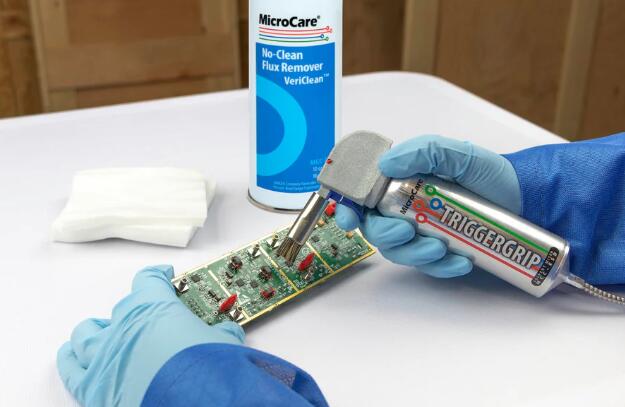During the manufacturing process of circuit boards, it is often necessary to use flux to better connect electronic components. However, after using flux, to ensure the normal operation of the circuit board, it is necessary to clean it.

Flux is a commonly used material for circuit board welding, which is used to clean the welded surface and prevent it from being oxidized again during the circuit board welding process. According to its morphology, it can be divided into three types: solid, liquid, and paste.
Method of cleaning with flux
1. Traditional cleaning methods
The traditional cleaning method is to use solvents or cleaning fluids to clean the soldering flux on the circuit board, but this method sometimes leads to residual flux, which affects the performance and stability of the circuit board. In addition, the volatility and flammability of solvents and cleaning fluids can also pose hazards to human health and the environment.
2. Dry ice cleaning method
The dry ice cleaning method is a non-contact cleaning method that uses dry ice particles as the cleaning medium and utilizes the low-temperature and high-speed impact force of dry ice to clean the soldering flux on circuit boards. Due to the extremely low temperature of dry ice, the flux can be frozen into a solid state in a short period and then removed from the circuit board through high-speed impact force. This method will not leave any residue and will not cause harm to the circuit board and the environment.
3. Water washing method
Water washing is the most common cleaning method. It uses pure water or deionized water to clean the flux. This method is simple, easy to implement, and also relatively low-cost. However, water washing may cause damage to some PCBs and components, such as water accumulation on the solder pads and pins of the components, leading to circuit short circuits or corrosion.
4. Solvent cleaning
Solvent cleaning is an efficient cleaning method. It uses chemical solvents to dissolve the flux and then rinses or sprays it off. Although this method can quickly and effectively clean the flux, the cost of solvents is high, and special attention needs to be paid to safety when using them.
5. Ion cleaning
Ion cleaning is a high-tech cleaning method that uses ion beams to clean PCB surfaces. Ion beams have high energy and speed, which can remove dirt and flux from the surface of PCBs. This method has an excellent cleaning effect and will not cause damage to PCBs and components. However, ion cleaning equipment is expensive and requires professional equipment and technical support.
Characteristics of cleaning agents for flux
Firstly, the cleaning agent used for soldering flux has a good cleaning effect. It can effectively remove flux residues without causing damage to the circuit board. This is very important because electronic circuit boards are usually very fragile, and improper use of cleaning agents can lead to damage.
Secondly, the cleaning agent used for soldering flux also has an anti-corrosion effect. During the cleaning process, it can remove oxides and other pollutants from the copper surface, thereby reducing copper corrosion. This is crucial for the long-term stability of electronic circuits.
Finally, the application range of cleaning agents for flux is very wide. It can be used to clean various types of electronic circuit boards, including single-panel, double-sided, and multi-layer boards. In addition, it can also be used to clean flux residues in other electronic devices.
Flux cleaning agent is a very important chemical agent that is safe, corrosion-free, easy to rinse, and residue-free for circuit boards. It has no impact on solder joints, circuits, etc. on circuit boards, and is phosphorus, nitrogen, lead, and heavy metal free. It can help electronic manufacturers maintain the quality and stability of circuit boards in the production process.